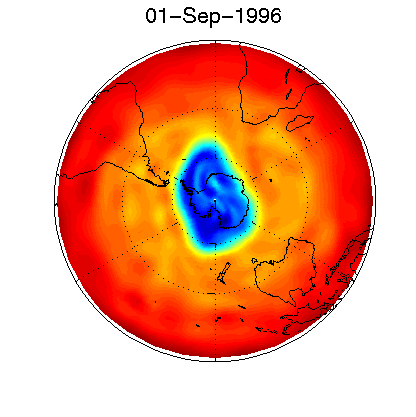Physical Overview
In the winter and springtime stratosphere, the flow is dominated by the
presence of a large vortex. The vortex is encircled by a strong eastward
flowing jet, the polar night jet. This jet is disturbed by planetary-scale
Rossby waves that propagate upward from the troposphere. The Rossby
waves break in the stratosphere, leading to a well-mixed stratospheric
``surf zone'' in the midlatitude region exterior to the vortex .
Despite this strong mixing mechanism, the vortex itself appears quite robust
and resistant to transport across its boundary. There is, however,
some disagreement as to whether a true transport barrier exists at the
vortex edge, or if the apparent barrier is in fact leaky. This would
imply an exchange of fluid between the vortex and the surrounding flow,
which is of particular interest in light of the infamous ozone hole.
|
Potential vorticity (PV) from UKMO data set.
|

|
The outer latitude ring is the equator, and the -30 and -60
degree South latitude rings are identified.
Blue corresponds to low PV in the vortex interior. The large
PV gradient identifies the vortex edge (light blue to yellow).
The surf zone is identified by the yellow/orange region exterior
to the vortex. |
As the polar region emerges from darkness in the spring, cold air permits
the formation of polar stratospheric clouds that serve as a reaction surface
for the photochemical destruction of ozone. This process occurs primarily
in the vortex interior, where the ozone hole forms. If the vortex
is indeed isolated, then the ozone-depleted air remains trapped inside
the vortex, cut off from ozone-rich air outside the vortex. If transport
does occur, however, then it is possible that current ozone depletion estimates
are inaccurate. In particular, the influx of ozone-rich air would
imply higher ozone destruction rates than currently thought. Therefore,
an understanding of the transport processes at work in this region of the
atmosphere is critical.
